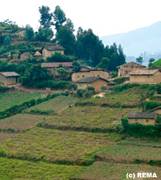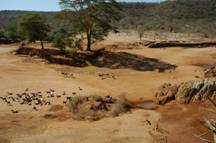Key Findings from the Millennium Ecosystem Assessment

- Scientists have no clear idea of how many species -- from algae to blue whales -- live on earth. Estimates are up to 100 million of which only about 1.8 million have been named so far. Humans are but one of those species.
- Though the exact number is impossible to determine, an unprecedented mass extinction of life on Earth is occurring. Scientists estimate that between 150 and 200 species of life become extinct every 24 hours.
- There have always been periods of extinction in the planet's history, but this episode of species extinction is greater than anything the world has experienced for the past 65 million years – the greatest rate of extinction since the vanishing of the dinosaurs.
- This mass extinction is due, in large measure, to humankind's unsustainable methods of production and consumption, including the destruction of habitats, expanding cities, pollution, deforestation, global warming and the introduction of "invasive species".
- "Climate change is forecast to become one of the biggest threats to biodiversity," the UN Convention on Biological Diversity said in a statement marking May 22.
- "Approximately 20-30 per cent of plant and animal species assessed so far are likely to be at greater risk of extinction if increases in global average temperature exceed 1.5 to 2.5 Celsius" (2.7 to 4.5 Fahrenheit), according to a report in April 2007 by the UN climate panel. Beyond that, it said ecosystems would face ever more wrenching changes.

- Biodiversity contributes directly or indirectly to many aspects of our well-being, for instance, by providing raw materials and contributing to health. More than 60 per cent of the world's people depend directly on plants for their medicines.
- Over the past century, many people have benefited from the conversion of natural ecosystems to agricultural land and from the exploitation of biodiversity. Although many individuals benefit from activities that lead to biodiversity loss and ecosystem change, the full costs borne by society often exceed the benefits.
- World leaders agreed at a 2002 UN Summit in Johannesburg to "achieve by 2010 a significant reduction of the current rate of biodiversity loss at the global, regional and national level as a contribution to poverty alleviation and to the benefit of all life on earth."
- To achieve greater progress towards biodiversity conservation, it will be necessary – but not sufficient – to urgently strengthen actions on the conservation and sustainable use of biodiversity and ecosystem services.
What is biodiversity?
 Biodiversity (biological diversity) reflects the number, variety and variability of living organisms and how these change from one location to another and over time. Biodiversity includes diversity within species (genetic diversity), between species (species diversity), and between ecosystems (ecosystem diversity).
Biodiversity (biological diversity) reflects the number, variety and variability of living organisms and how these change from one location to another and over time. Biodiversity includes diversity within species (genetic diversity), between species (species diversity), and between ecosystems (ecosystem diversity).
Biodiversity is important in all ecosystems, not only in those that are "natural" such as national parks or natural preserves, but also in those that are managed by humans, such as farms and plantations, and even urban parks. It is the basis of the multiple benefits provided by ecosystems to humans.
Where is biodiversity?
 Life, and thus biodiversity, is essentially everywhere on Earth's surface and in every drop of its bodies of water. The best known dimension of biodiversity is the classification of animals and plants into species, which mainly focuses on animals observable to the naked eye.
Life, and thus biodiversity, is essentially everywhere on Earth's surface and in every drop of its bodies of water. The best known dimension of biodiversity is the classification of animals and plants into species, which mainly focuses on animals observable to the naked eye.
What is the link between biodiversity and ecosystem services?
 Ecosystem services are the benefits obtained by people from ecosystems. These include:
Ecosystem services are the benefits obtained by people from ecosystems. These include:
- provisioning services such as food, clean water, timber, fiber, and genetic resources;
- regulating services such as the regulation of climate, floods, disease, water quality, and pollination;
- cultural services such as recreational, aesthetic, and spiritual benefits;
- supporting services such as soil formation, and nutrient cycling.
Biodiversity plays an important role in the way ecosystems function and in the services they provide. The local loss of an essential species can disrupt ecosystem services for a long time. Changes in the interactions between species can also lead to negative impacts on ecosystem processes.
- The preservation of resident species can enhance resistance of a wide range of natural and semi-natural ecosystems against invasive species.
- There have been worldwide declines in the diversity of pollinating insects that are essential for the reproduction of many plants.
- Biodiversity, in particular the diversity of plant forms and the distribution of landscape patches, influences climate at local, regional, and global scales. Some components of biodiversity affect carbon sequestration and thus are important in fighting climate change.
- The ecosystem's ability to control pests is strongly dependent on biodiversity and benefits food security, rural households, and national incomes of many countries.
- The microbes living in the sea contribute to pollution control by removing toxic substances from the environment, but how species diversity influences this removal is not well understood.
Why is biodiversity loss a concern?
 Biodiversity is essential for the benefits the ecosystems can provide to humans and hence for human well-being. Its role goes beyond ensuring the availability of raw materials to include security, resiliency, social relations, health, and freedoms and choices.
Biodiversity is essential for the benefits the ecosystems can provide to humans and hence for human well-being. Its role goes beyond ensuring the availability of raw materials to include security, resiliency, social relations, health, and freedoms and choices.
Biodiversity loss has direct and indirect negative effects on several factors:
Food security: The availability of biodiversity is often a "safety net" that increases food security and the adaptability of some local communities to external economic and ecological disturbances.
Vulnerability: Many communities have experienced more natural disasters over the past several decades. For example, because of the loss of mangroves and coral reefs, which are excellent natural buffers against floods and storms, coastal communities have increasingly suffered from severe floods.
Health: A balanced diet depends on the availability of a wide variety of foods, which in turn depends on the conservation of biodiversity.
Energy security: Wood fuel provides more than half the energy used in developing countries. Shortage of wood fuel occurs in areas with high population density without access to alternative and affordable energy sources. In such areas, people are vulnerable to illness and malnutrition because of the lack of resources to heat homes, cook food, and boil water.
Clean water: The continued loss of forests and the destruction of watersheds reduce the quality and availability of water supplied to household use and agriculture. In the case of New York City, protecting the ecosystem to ensure continued provision of clean drinking water was far more cost-effective than building and operating a water filtration plant.
Social relations: Many cultures attach spiritual, aesthetic, recreational, and religious values to ecosystems or their components.
Freedom of choice: Loss of biodiversity, which is sometimes irreversible, often means a loss of choices. The notion of having choices available irrespective of whether any of them will be actually picked is an essential constituent of the freedom aspect of well-being.
Basic materials: Biodiversity provides various goods - such as plants and animals - that individuals need in order to earn an income and secure sustainable livelihoods. In addition to agriculture, biodiversity contributes to a range of other sectors, including ecotourism, pharmaceuticals, cosmetics, and fisheries.
What competing goals can affect biodiversity?
 When humans modify an ecosystem to improve one of the services it provides this generally results in changes to other ecosystem services. For example, actions to increase food production can lead to reduced water availability for other uses, and degraded water quality. In the long term, the value of services lost may greatly exceed the short-term economic benefits that are gained from transforming ecosystems.
When humans modify an ecosystem to improve one of the services it provides this generally results in changes to other ecosystem services. For example, actions to increase food production can lead to reduced water availability for other uses, and degraded water quality. In the long term, the value of services lost may greatly exceed the short-term economic benefits that are gained from transforming ecosystems.
What is the value of biodiversity for human well-being?
 Unlike goods bought and sold on markets, many ecosystem services do not have markets or readily observable prices. This means that the importance of biodiversity and natural processes in producing ecosystem services that people depend on is not reflected in financial markets.
Unlike goods bought and sold on markets, many ecosystem services do not have markets or readily observable prices. This means that the importance of biodiversity and natural processes in producing ecosystem services that people depend on is not reflected in financial markets.
Degradation of ecosystem services could be significantly slowed or reversed if their full economic value were taken into account in decision-making.
A way of assigning monetary values to them is to rely on non-market valuation methods. These methods have been applied to clean drinking water, recreation, or commercially harvested species.
Non-market values can be either the value to society from the active use of the asset or a "non-use" value, which reflects the value of an asset beyond any use, such as the value of existence of species.
The private use value of biodiversity and ecosystem services by individuals will typically ignore the "external" benefits of conservation to society in general. For example, a farmer may benefit from intensive use of the land but generally does not bear all the consequences caused by leaching of excess nutrients and pesticides into ground or surface water, or the consequences of loss of habitat for native species.
Intensive use of ecosystems often produces the greatest short-term advantage, but excessive and unsustainable use can lead to losses in the long term. A country could cut its forests and deplete its fisheries, and this would show only as a positive gain to GDP, despite the loss of capital assets, because of the income generated by the sale of those products.
Moreover, many ecosystem services, such as groundwater, are available freely to those who use them and so again their degradation is not reflected by standard economic valuation methods.
How are the impacts of biodiversity loss distributed geographically?
 The changes in ecosystems are harming many of the world's poorest people, who are less able to adjust to these changes and who are affected by even greater poverty, as they have limited access to substitutes or alternatives. For example, poor farmers often cannot afford using modern methods for services previously provided by biodiversity.
The changes in ecosystems are harming many of the world's poorest people, who are less able to adjust to these changes and who are affected by even greater poverty, as they have limited access to substitutes or alternatives. For example, poor farmers often cannot afford using modern methods for services previously provided by biodiversity.
Poor people have historically disproportionately lost access to biological products and ecosystem services as demand for those services has grown. The transfer in ownership of ecosystem resources often excludes local communities, and the products of their exploitation are not destined for the local market.
What are the current trends in biodiversity?
 For all aspects of biodiversity, current pace of change and loss is hundreds of times faster than previously in recorded history and the pace shows no indication of slowing down.
For all aspects of biodiversity, current pace of change and loss is hundreds of times faster than previously in recorded history and the pace shows no indication of slowing down.
Virtually all of Earth's ecosystems have been dramatically transformed through human actions, for example, 35% of mangrove and 20% of coral reef areas have been lost. Across the world, ecosystems have continued to be converted for agricultural and other uses at a constant pace over at least the last century.
Species extinction is a natural part of Earth's history. However, over the past 100 years humans have increased the extinction rate by at least 100 times compared to the natural rate. The current extinction rate is much greater than the rate at which new species arise, resulting in a net loss of biodiversity.
What factors lead to biodiversity loss?
 Some of the key drivers include land use change, climate change, invasive species, overexploitation, pollution, and changes in human population, incomes or lifestyle.
Some of the key drivers include land use change, climate change, invasive species, overexploitation, pollution, and changes in human population, incomes or lifestyle.
Changes in biodiversity are driven by combinations of these drivers that work over time, on different scales, and that tend to amplify each other. For example, population and income growth combined with technological advances can lead to climate change.
Historically, habitat and land use change have had the biggest impact on biodiversity in all ecosystems, but climate change and pollution are projected to increasingly affect all aspects of biodiversity.
Overexploitation and invasive species have been important as well and continue to be major drivers of changes in biodiversity.
How is climate change affecting biodiversity?
 Recent changes in climate, such as warmer temperatures in certain regions, have already had significant impacts on biodiversity and ecosystems. They have affected species distributions, population sizes, and the timing of reproduction or migration events, as well as the frequency of pest and disease outbreaks.
Recent changes in climate, such as warmer temperatures in certain regions, have already had significant impacts on biodiversity and ecosystems. They have affected species distributions, population sizes, and the timing of reproduction or migration events, as well as the frequency of pest and disease outbreaks.
Projected changes in climate by 2050 could lead to the extinction of many species living in certain limited geographical regions. By the end of the century, climate change and its impacts may become the main direct driver of overall biodiversity loss.
How might biodiversity change in the future under various plausible scenarios?
 The Millennium Ecosystem Assessment developed four plausible scenarios to explore the future of biodiversity and human well-being until 2050 and beyond. The different scenarios are based on either increased globalization or increased regionalization, and an either reactive or proactive way of addressing environmental issues.
The Millennium Ecosystem Assessment developed four plausible scenarios to explore the future of biodiversity and human well-being until 2050 and beyond. The different scenarios are based on either increased globalization or increased regionalization, and an either reactive or proactive way of addressing environmental issues.
Overall, in all four scenarios, agricultural land will expand and forest cover will shrink, particularly in developing countries. This will lead to a continuing decline in local and global biodiversity, mainly as a result of habitat loss. More proactive approaches to the environment will be more successful in slowing these trends.
Human well-being will be affected by biodiversity loss both directly and indirectly. Direct effects include an increased risk of sudden environmental changes such as fisheries collapses, floods, droughts, wildfires, and disease.
Changes will also affect human well-being indirectly, for instance in the form of conflicts due to scarcer food and water resources.
Though the average income per person (GDP) is projected to rise in all scenarios, this can mask increased inequity for instance in terms of food security. Major decisions will have to address trade-offs between competing goals, for instance between agricultural production and water quality, or between water use and aquatic biodiversity.
What actions can be taken to conserve biodiversity?
 Protected areas are an essential part of conservation programs, but they are not sufficient by themselves to protect the full range of biodiversity and can be difficult to enforce. To be successful, sites for protected areas need to be carefully chosen, ensuring that all regional ecosystems are well represented, and the areas need to be well designed and effectively managed.
Protected areas are an essential part of conservation programs, but they are not sufficient by themselves to protect the full range of biodiversity and can be difficult to enforce. To be successful, sites for protected areas need to be carefully chosen, ensuring that all regional ecosystems are well represented, and the areas need to be well designed and effectively managed.
Market tools, such as direct payments for ecosystem services or transfers of ownership rights to private individuals, can provide economic incentives to conserve biodiversity and to use ecosystem services sustainably.
Prevention and early intervention have proven to be the most successful and cost-effective way of tackling invasive species. Once an invasive species has become established, its control and particularly its eradication through the use of chemicals or through the introduction of other species is not necessarily effective and is extremely difficult and costly.
To be conserved, biodiversity must be integrated into the agriculture, fishery, and forestry sectors. These sectors are directly dependent on biodiversity and affect it directly. The private sector can make significant contributions, for example by adopting certain agricultural practices.
International agreements need to include enforcement measures and take into account impacts on biodiversity and possible synergies with other agreements. Most direct actions to halt or reduce biodiversity loss need to be taken at local or national level.
Informing all of society about the benefits of conserving biodiversity, and explicitly considering trade-offs between different options in an integrated way, helps maximize the benefits to society. Ecosystem restoration is generally far more expensive than protecting the original ecosystem, but is becoming increasingly important as more areas become degraded.
